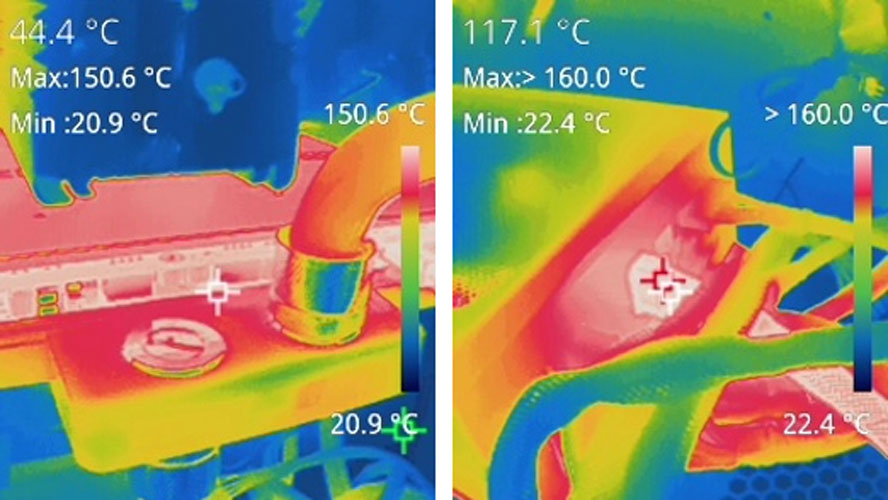Nvidia RTX 5090's 16-pin power connector hits 150C in reviewer's thermal camera shots
Andreas Schilling of Germany's Hardware Luxx says the power connector issue will 'forever remain a weak point of this generation.'

Some thermal imagery shared on Twitter/X underlines how toasty-hot power connectors servicing Nvidia GeForce RTX 5090 graphics cards can get. Veteran hardware reviewer Andreas Schilling, an editor at Germany's Hardware Luxx, took thermal photos of his water-cooled graphics card.
While the GPU barely broke a sweat, the power connectors could be seen "cooking at 150+ degrees." That's Celsius, and for those unfamiliar with metric units, 150 degrees Celsius equates to just over 300 degrees Fahrenheit.
Though reviewers at Tom's Hardware haven't experienced dangerously hot 12V-2x6 cable connectors first-hand, reports indicate this issue can affect anyone—from seasoned hardware veterans to budding enthusiasts. In previous generations and with earlier iterations of the 16-pin connector, there was often a nagging doubt about 'user error, ' but we seem to be fully past that notion now. We must face up to the problem that RTX 5090 power cables may be doomed to burn.
While doing some thermal imaging of a graphics card and reviewing the images, I noticed, that the camera picked up a hotspot at the PSU. The 12V-2x6 cable was cooking at 150+ degrees. This is no joke and will forever remain a weak point of this generation(s). pic.twitter.com/qTMfgTwUr0March 7, 2025
Schilling provided some background information on the thermal imagery he shared. The graphics card he was testing was a liquid-cooled Inno3D RTX 5090 Frostbite, and one of the images clearly shows the pipe fittings. The PSU in this PC build was a be quiet! Dark Power 13 and Schilling confirmed that the GPU pulled 600W during tests.
The Hardware Luxx editor sounds like he has run out of patience with Nvidia's graphics card power connector(s) choice. "The 12V-2x6 cable was cooking at 150+ degrees," he observed, backed up by the thermography. "This is no joke and will forever remain a weak point of this generation(s)."
This power connection "will forever remain a weak point"
Prompted by social media interest in the visuals, Schilling added some extra details. He said the cabling looked like it was still for now, despite the high temperatures seen. "But you can see that they have been subjected to thermal stress. I have zero trust in that solution of any kind," blasted the reviewer.
Later, Schilling recalled that the PSU-to-cabling mating cycles were still very low, "a handful." However, the connector might have been plugged and unplugged "several hundred" times on the GPU side. That second figure seems well beyond the 12V-2x6 connector's "mating cycle life of 30 cycles," mentioned by Corsair. The images show the unexpectedly high temperatures on both sides—the graphics card and PSU connections.
Get Tom's Hardware's best news and in-depth reviews, straight to your inbox.
Before we go, it is important to remember that thermal cameras measure surface temperatures so that things could be far hotter inside the plastic connectors. Schilling didn't see actual melting during his later inspections but said there was evidence of some thermal stress. We expect the 12V-2x6 connector to use the same Nylon 66 and LCP housing as per 12VHPWR specs. The former has a melting point of 255 degrees Celsius (491 degrees Fahrenheit), and the latter melts above 335 degrees Celsius (635 degrees Fahrenheit).
Thankfully, Schilling's power connectors must not have quite reached these thresholds inside, but extended testing and use of this build – without changes – sounds like it could be hazardous.

Mark Tyson is a news editor at Tom's Hardware. He enjoys covering the full breadth of PC tech; from business and semiconductor design to products approaching the edge of reason.
-
usertests If you're going to force everyone to adopt a new connector, how about making something that isn't the same Molex design from decades ago, but worse?Reply
These things need to burn right off the market. -
spiketheaardvark It's there a reason we have decided to use lots of little wires to supply the most power hungry part of a computer instead of two big wires with a nice secure connection?Reply -
tom2tec Classism is getting bad when our top corporations are this corrupt and incompetent. Where is the safety certification happening? Why were these ever approved? The public deserves answers.Reply -
VizzieTheViz Reading this a short time after the article where MSI and NVidia say this connector is totally cool and not a fire hazard at all is pretty funny.Reply -
Alex/AT Reply
There actually is a reason. It's not only about wire size, it's also about component size and board interconnect volume (size). It's not enough to put single high-loaded wire to the board, you also need to carry this power further through the board, and components must be able to sustain the flow. Thus, multiple small wires are easier to maintain than just two large ones. And no, splitting it right on board is not going to be easy/funny as well (look at how stuff is split inside 1000W PSU and what size it all is...).spiketheaardvark said:It's there a reason we have decided to use lots of little wires to supply the most power hungry part of a computer instead of two big wires with a nice secure connection?
Considering this, just 4 x normal 8-pin PCI power connectors would've been a better job. They have enough sturdiness to spare and they are extremely time proven. Also loss of a single cable or slight misbalance won't kill them with wire count this high and GPU would have time to just power-throttle instead of burning up.
I suspect the use of 'brand new hot burning' connector also stems from a requirement it all must be from a single balanced bus (phase), and doing 4x8pin may lead to user errors of connecting these from different PSU buses (high power PSUs tend to have more than one circuit / bus) which will in turn require careful board design to not surge between the buses on the board itself. But this is totally doable given even GPU is totally not uniform inside.
Still, VHPWR must die either way, and that's the bottom line. It's almost an epitome of bad design. Burn baby burn. -
Heat_Fan89 Reply
Get out the Bat fire extinguisher !Admin said:Some thermal imagery shared on Twitter/X underlines how toasty-hot power connectors servicing Nvidia GeForce RTX 5090 graphics cards can get.
Nvidia RTX 5090's 16-pin power connector hits 150C in reviewer's thermal camera shots : Read more
https://i.pinimg.com/originals/e4/e5/73/e4e57388e9ca77a7ae3d0863d52e046c.jpg -
Notton Reply
There kind of was, back when PSUs had multiple 12V rails and the 8-pin EPS and PCIe were on separate ones.spiketheaardvark said:It's there a reason we have decided to use lots of little wires to supply the most power hungry part of a computer instead of two big wires with a nice secure connection?
There's supposed to be OCP (Over Current Protection) on each 12V rail, which was supposed to prevent cable fires, along with prevent shorts from destroying other components in the system.
Multiple 12V rail PSUs were the hot new thing.... I think in 2000~2005? because CPUs and GPUs were starting to pull enough power to require an extra 4-pin EPS and 6-pin PCIe. Mysteriously, the pin-out for 8-pin EPS and 8-pin PCIe are different (foreshadowing).
But then somewhere along the line Nvidia/PCISIG decided to throw all of that out the window and we're back to a single 12V rail that can pump 600W over 2 cables and a high resistance connector.
Now, the real kicker is, Nvidia/PCISIG didn't have to use this idiotic 16-pin fire connector.
The XT90, which can handle 90A, designed for Lithium batteries, in RCs existed since at least 2015. IDK the exact date, but the fire hazard 16-pin connector was introduced in 2022. Even if Nvidia was prototyping the 16-pin in 2019/2020, the XT90 connector predated it by at least 5 years. -
Alex/AT Reply
Same stuff I presume. Multiple bus (rails), so spikes from high-power peripheral rail can't hurt high frequencies-sensitive board/CPU rail. Thus these were deliberately made different to disallow mixup.Notton said:Mysteriously, the pin-out for 8-pin EPS and 8-pin PCIe are different (foreshadowing).
Modern 1000W+ PSUs also are easily encountered multiple-railed. Some offer to mix rails, but efficiency depletes and surge/noise level soars. -
TJ Hooker Reply
The industry was transitioning back to single rail years before 12VHPWR came on the scene.Notton said:Multiple 12V rail PSUs were the hot new thing.... I think in 2000~2005? because CPUs and GPUs were starting to pull enough power to require an extra 4-pin EPS and 6-pin PCIe. Mysteriously, the pin-out for 8-pin EPS and 8-pin PCIe are different (foreshadowing).
But then somewhere along the line Nvidia/PCISIG decided to throw all of that out the window and we're back to a single 12V rail that can pump 600W over 2 cables and a high resistance connector.
Do you have some examples of modern PSUs with multiple 12V rails? Because AFAIK single rail has been more common for a decade or more, even for high power PSUs.Alex/AT said:Modern 1000W+ PSUs also are easily encountered multiple-railed.